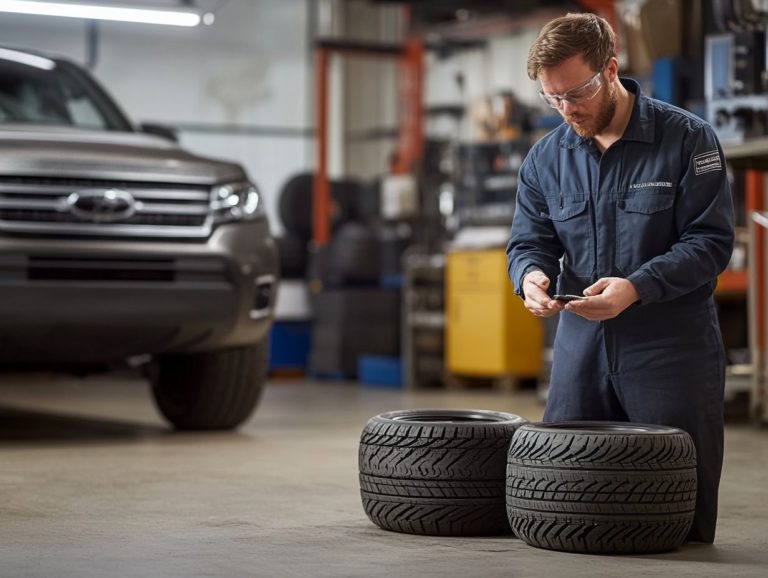What Are the Benefits of Regular Tire Rotation?
Don’t overlook tire rotation! It s essential for keeping your vehicle in top shape. This straightforward yet crucial maintenance task can greatly extend the lifespan of your tires and elevate your vehicle s performance.
This article delves into what tire rotation is, why it’s vital for both tire longevity and vehicle efficiency, and how frequently you should be doing it. You ll also uncover a step-by-step guide for rotating your tires, complete with insights on how this routine can save you money over time.
Explore how regular tire rotation enhances your safety on the road and maximizes your investment in your vehicle.
Contents
Key Takeaways:

- Regular tire rotation is vital for maintaining tire health and improving vehicle performance.
- Rotating tires every 5,000-7,000 miles helps ensure even tread wear and extends tire lifespan.
- Proper tire rotation can save you money in the long run by preventing premature tire replacement and improving fuel efficiency.
What is Tire Rotation?
Tire rotation is an essential part of your vehicle’s regular maintenance. It involves periodically changing the position of each tire to promote even tread wear and enhance overall performance.
This process not only extends the lifespan of your tires but also boosts fuel efficiency and safety. By rotating your tires at the recommended intervals, you can optimize handling and traction, significantly reducing the risk of uneven wear patterns which means tires wearing out at different rates.
Typically, it’s advisable to rotate your tires every 5,000 to 7,500 miles, depending on your vehicle type and tire design. During this procedure, the front tires are moved to the rear and vice versa, with occasional side-switching as well. This practice ensures that your tires wear uniformly, which is vital for maintaining control during turns and shortening braking distances.
Sticking to a maintenance schedule that includes tire rotation keeps your tires performing at their best and ensures you enjoy a smoother, safer driving experience. This proactive approach protects you against potential accidents from compromised tire integrity.
Importance of Regular Tire Rotation
Regular tire rotation is essential for ensuring your vehicle operates at its best and enjoys a long lifespan. It effectively prevents uneven wear, which can cause handling issues and pose safety risks.
By sticking to a consistent maintenance schedule, you ll reap the rewards of improved fuel efficiency, enhanced traction, and an overall superior driving experience.
Benefits for Tire Health
Maintaining tire health through regular rotation is crucial for extending the lifespan of your tires. It helps reduce the risk of uneven tread wear, which can jeopardize your road safety and vehicle performance.
By ensuring that your tires are balanced and rotated according to best practices, you can enjoy a smoother ride and enhanced vehicle control, leading to significant cost savings over time. This practice boosts safety and promotes better fuel efficiency. When your tires wear evenly, they provide optimal traction and grip on various road surfaces.
Regular tire rotation allows for an even distribution of wear, which is essential in preventing premature tire replacement an expense that can add up quickly. Incorporating tire balancing into your routine maintenance means adjusting the weight of the tire to ensure it wears evenly.
This helps mitigate vibrations that could lead to suspension issues, protecting other essential components of your vehicle. The benefits of sticking to a regular tire rotation schedule go beyond just the tires themselves; they contribute to a healthier vehicle and a more enjoyable driving experience.
Schedule your tire rotation today to ensure your vehicle remains in top condition!
Unlock the Benefits of Tire Rotation!

Regular tire rotation is a game-changer for your vehicle! By improving traction and minimizing handling issues, it reduces road noise, creating a more comfortable and enjoyable driving experience.
With optimal tire performance, you’ll enjoy enhanced vehicle control and responsiveness, making every journey safer and more pleasurable. Methodically changing the position of your tires ensures even wear on all four tires, leading to better contact with the road surface.
This balance maximizes grip during sudden maneuvers or adverse weather conditions and makes steering feel precise and predictable.
As a result, a well-maintained set of tires translates to shorter stopping distances and smoother rides, boosting your overall driving confidence. Regular rotations can extend the lifespan of your tires, saving you money in the long run and keeping you from being sidelined by unexpected tire issues.
When and How Often to Rotate Tires
Determining the right timing for tire rotation is essential for preserving optimal tire health and performance. Many experts suggest rotating your tires every 5,000 to 7,500 miles. However, this can vary based on your driving conditions and habits.
By following this maintenance schedule, you’ll ensure that your tires wear evenly. This ultimately extends their lifespan and improves both fuel efficiency and driving safety.
Recommended Mileage and Frequency
The recommended mileage for tire rotation typically falls between 5,000 and 7,500 miles, but variations exist based on tire types and driving conditions. Consult your vehicle’s manual or reach out to a trusted Mazda dealer for tailored guidelines.
In urban environments, where stop-and-go traffic is the norm, or if you often go off-road, more frequent rotations may be necessary potentially narrowing that range to every 3,000 to 5,000 miles. The type of tires you have, whether all-season, performance, or winter, will also impact wear patterns and rotation frequency.
Regularly check your tread depth and be attuned to your steering performance for valuable clues about when a rotation is due. Check your tires today and ensure they’re ready for the road!
How to Rotate Tires
Follow this simple guide to rotate your tires with ease! Rotating your tires is not just a routine task; it s a step-by-step process that guarantees even wear and peak performance.
Don t underestimate the importance of proper alignment and balancing during this procedure. These elements are essential for preventing problems that can cause your vehicle to pull to one side and ensuring optimal vehicle control on the road.
Step-by-Step Guide

To successfully rotate your tires, follow these steps:
- Gather essential tools: a jack, jack stands, a lug wrench, and a torque wrench.
- Always park on a flat surface for your safety and engage the parking brake.
- Loosen the lug nuts slightly before lifting the vehicle with the jack to prevent any potential injuries.
- Once your vehicle is elevated and securely supported by jack stands, carefully rotate the tires according to the recommended pattern for your specific vehicle, whether it s front-to-back or side-to-side.
Following a clear method will improve tire wear and performance, ultimately leading to a smoother ride.
Cost Savings and Long-Term Benefits
Investing in regular tire rotation can yield substantial cost savings and long-term advantages. By rotating your tires, you reduce the need for premature tire replacements and enhance your vehicle’s fuel efficiency.
Extending the lifespan of your tires ensures optimal performance. It also allows for a more economical and safer driving experience. It also maximizes your tire warranty benefits, making it a smart choice overall.
How Regular Tire Rotation Can Save You Money
Regular tire rotation is a smart move that can save you money. It extends the lifespan of your tires and minimizes the risk of costly repairs due to worn tires.
By sticking to a consistent maintenance schedule, you can enjoy improved control and performance while reducing overall transportation costs. This proactive approach guarantees a smoother ride and significantly decreases how often you need to replace your tires, leading to long-term savings.
Keep in mind that worn tires can create alignment issues. If ignored, these may result in expensive repairs to your suspension system.
Make regular tire rotations a part of your routine to save money! This habit promotes a more efficient vehicle that consumes less fuel, enhancing your overall driving experience with improved safety and cost-effectiveness.
Watch this video to learn more about tire rotation benefits!
Frequently Asked Questions
What Are the Benefits of Regular Tire Rotation?

Regular tire rotation has several benefits for your vehicle, including:
- Even wear and tear on tires
- Improved overall lifespan
- Better fuel efficiency
Why Should I Rotate My Tires?
Tire rotation helps distribute wear evenly, improving their overall lifespan.
How Often Should I Have My Tires Rotated?
Most experts recommend rotating your tires every 5,000 to 8,000 miles or every six months, whichever comes first.
What Happens If I Don’t Rotate My Tires Regularly?
If you neglect tire rotation, your tires may wear unevenly, leading to decreased performance and potentially a blowout.
Does Regular Tire Rotation Save Me Money in the Long Run?
Yes, rotating your tires can save you money in the long run by extending their lifespan and preventing premature replacements.
Can I Rotate My Tires Myself, or Should I Go to a Professional?
While you can rotate your own tires, it’s recommended to have a professional do it. They have the necessary equipment and expertise.
Don t wait! Schedule your tire rotation today to keep your vehicle running smoothly!






